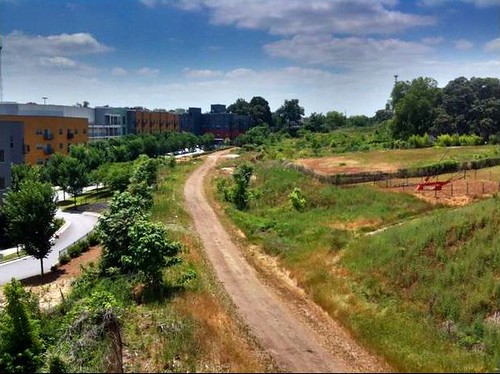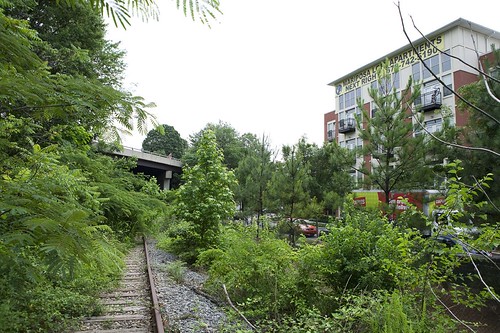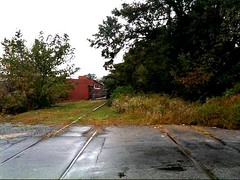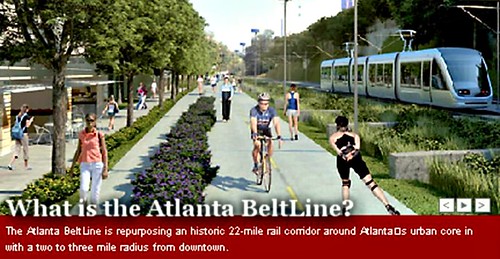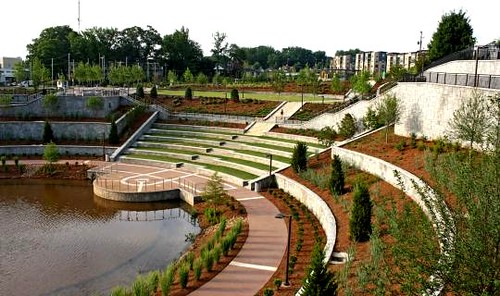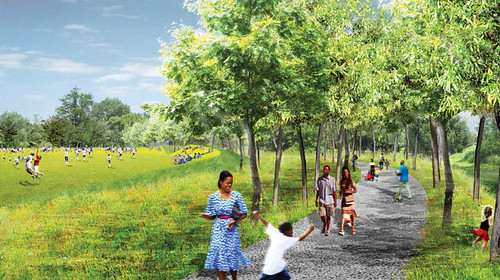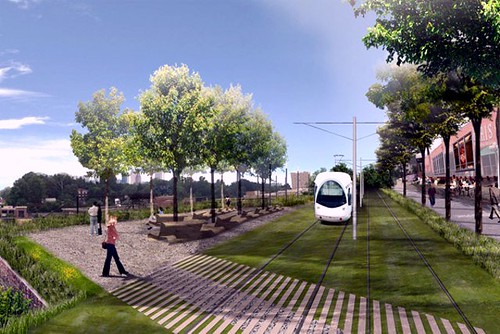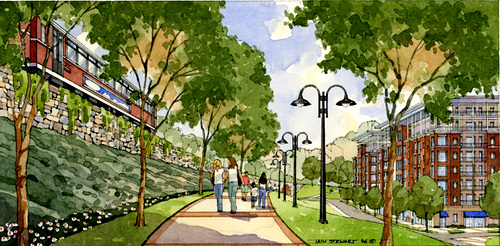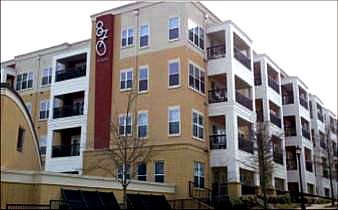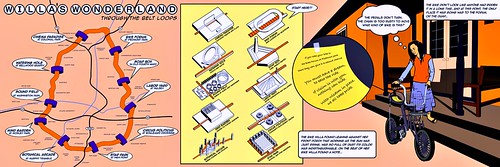The country's most ambitious smart growth project shows some progress, much remaining potential

Posted July 26, 2011 at 1:27PM
I once called the Atlanta BeltLine “the country’s best smart growth project.” I still haven’t seen one that is better in concept. But now, with a few years of history, how is the implementation coming along? Is the reality matching the vision?
The challenge with writing about the BeltLine is that the massive public/private undertaking is so enormous, so multifaceted, so ambitious and potentially transformative, so complicated that it is difficult to know where to start, how much to say, and what comments are fair. I’ll try to boil it down to a few impressions that I have formed as a highly interested observer from afar:
1. The concept remains extraordinarily impressive.
To briefly review the basics, the city is seeking to invest some $2.8 billion in a new, 22-mile public transit, trails and parks loop around the heart of the city of Atlanta on the site of an abandoned rail and industrial corridor. Because the BeltLine passes through some of the inner city’s most distressed neighborhoods, the intent is for this major public investment to leverage substantial private investment in revitalization, particularly workforce housing. 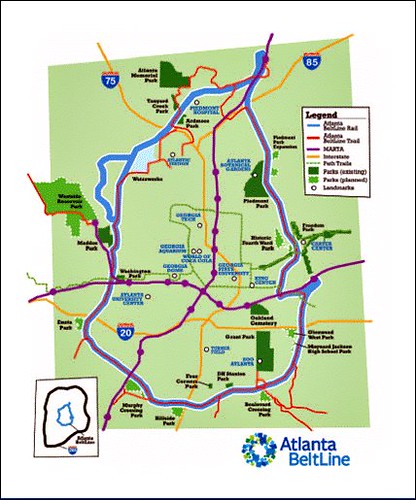 The transit is to be either light rail or streetcars, connecting in several places along the loop to the MARTA regional rail transit system.
The transit is to be either light rail or streetcars, connecting in several places along the loop to the MARTA regional rail transit system.
Around 2000 acres of new, expanded and improved parks are involved, all of which will be linked by a multi-use trail, itself a linear park, along the BeltLine as well as by the transit loop. Many of the parks are being designed to include significant green management features. The project will also involve the remediation of over a thousand acres of brownfields.
The hoped-for economic impacts include 5600 units of workforce housing, 30,000 permanent jobs and 48,000 person-years of construction jobs, and a $20 billion increase in the city’s tax base over 25 years. It’s an incredible bundle of related public benefits if the city and its partners can pull this off.
2. Visible benefits so far include but are largely limited to parks and trails.
Last week, a representative of the Atlanta Beltline Partnership, a fundraising and outreach affiliate of the initiative, helpfully sent me her organization’s new annual report, along with the latest report from Atlanta BeltLine, Inc. (ABI), the entity created by the city to oversee the project’s implementation. (The Partnership and ABI jointly sponsor the BeltLine’s web site.) Both point to some significant achievement in the development and improvement of parks as a result of the initiative.
From the Partnership’s report:
“All over the city, the Atlanta BeltLine is beginning to take shape. In the West End, a multi-use trail is complete. Work is underway on a walking and biking path on Atlanta’s east side. And in the Old Fourth Ward, in the heart of the city, a signature park is emerging.”
Of the 20 pages of ABI’s report allocated to substantive accomplishment, 14 are devoted to parks and green space. Perhaps the most impressive of the parks work to date is the new (if awkwardly named) Historic Fourth Ward Park on the east side of the Beltline (photo above, site plan below). Critic Jonathan Lerner writes of the park:
“But I can say — from the times I have slipped through an opening in the fence to explore during the construction — that this is a transformative space. Its centerpiece is a sinuously shaped “lake” sunk deep into the topography that does double duty. It provides a focal point and — edged by boardwalks, bridges and piers, terraces and fountains, and a gracious amphitheater — will be an inviting activity center.
“More mundanely, it functions as a stormwater detention device for this historically flood-prone location. The artificial declivity dug for the lake — emphasized by soaring granite retaining walls — along with the natural, gentler rise of the park’s topography beyond it toward the east,
south and west, creates long views up and down and lots of visual drama. The descent into it and the soft, curvaceous shapes of its hardscape and waterscape are a respite from the Historic Fourth Ward’s sharp-edged buildings and rectilinear street grid.”
The park’s 17 acres include some significant green technology, according to ABI’s report:
- “The purpose of the lake is to provide capacity relief to the combined sewer system and is designed to integrate aesthetically with the surrounding Historic Fourth Ward Park while meeting federal consent decree requirements.
- “Converts five acres of former contaminated industrial land into a clean, green public space.
- “City of Atlanta’s first water-neutral park: all irrigation needs will be met by the storm water basin and no water will be drawn from the City’s water supply.
- “Utilizes energy-efficient LED lighting to minimize energy costs and provide a secure environment.”
The park also includes a nifty and quite sophisticated skate park.
Among additional green features in new BeltLine parks, the new 8-acre D.H. Stanton Park on the Beltline’s south side is equipped with solar panels that, ABI says, will generate enough electricity to completely offset the park’s energy costs. And the report drily notes that the BeltLine’s new, 5-acre Boulevard Crossing Park (really, improve these names) was facilitated by an “innovative partnership with Trees Atlanta [that] used 24 goats to clear 1.5 acres of invasive kudzu over a three-week period in Fall 2010.”
Work has also begun on several miles of trails (see above) in at least three segments of the BeltLine. Some portions are finished and open to the public, while other portions are sufficiently cleared for “interim hiking.”
3. The transit isn’t coming for a while.
These accomplishments notwithstanding, for an urbanist like myself the transit loop is the most important public-funded element of the BeltLine by far. Experience in other cities demonstrates that, in addition to improving transportation efficiency, fixed-route transit can be a powerful catalyst for development and private investment. But, without it, the BeltLine’s benefits will be limited at best.
Here’s some of what the ABI report says about transit:
“ABI and MARTA are partnering to finalize the Atlanta BeltLine’s Tier I Environmental Impact Statement (EIS) on behalf of the Federal Transit Administration, a major milestone in the federal funding process for transit. As part of the Atlanta BeltLine Corridor Design project, transit is being conceptually designed and
integrated with the proposed trail and greenspace elements of the Atlanta BeltLine; station locations and alignment are being refined; and cost estimates are being updated.
“In the upcoming year, ABI will create a Transit Implementation Strategy, initiate a Tier 2 EIS for a portion of the corridor and continue transit design and engineering through the Corridor Design and other planned projects. This work will serve as the blueprint for transit implementation and progress segments of transit to the point that they may proceed to preliminary engineering activities. This will include identification and screening of alternatives, conceptual engineering, ridership modeling, cost estimating, financial planning and operational and maintenance planning. The Transit Implementation Strategy is anticipated to identify at least two specific segments of transit to be moved into design and/or construction in the next five years. These segments may connect the redevelopment corridor along the Atlanta BeltLine to activity centers in the core of the city.”
Hmmm, there’s a lot of deliberate uncertainty written into those paragraphs. Even the near-term projects are described as "moved into design" in the next five years . . . I suspect that, put another way, the city doesn’t believe it is in a position to make promises. But, meanwhile, there are apparently some things it can do – things that are going to have to be done anyway – while it continues to search for funding (and perhaps more political support?).
One can’t help but wonder why the “transit implementation strategy” was still in the future as of the end of 2010 when the report was prepared. I also wonder if there has been internal competition among worthy transit projects for funding: when the federal Department of Transportation’s TIGER grants were being handed out last year, the money for Atlanta went for the downtown streetcar, not the BeltLine.
I am certainly not going to argue which project was a better candidate; presumably the city made an informed decision about which was more likely to attract funds, and I have no reason to doubt their judgment. I don’t know how advanced the planning for the streetcar was at the time, for example, but surely it was more advanced than that for the BeltLine. That said, if a project of the BeltLine’s massive ambition is to succeed, sooner or later it is going to have to become the top transit priority for the city. It’s just too complicated to get done otherwise.
In the meantime, I suppose it made sense to lead with parks and green space rather than with transit. As challenging as the land acquisition, remediation, design, public engagement and funding can be for parks, that bundle becomes far more formidable when it comes to a rail line. The public is at least getting to see some near-term accomplishment in the parks and trails.
But a case can also be made for going all-out at least for a segment, however short, of the transit line right from the start, even if they had to begin with a bus line. This would have sent an immediate signal to the public as well as to private investors that this project is fundamentally about transit. The unfortunate experience here in the DC area is that, once a community comes to love a parks-and-trail corridor, some of them will actually oppose the transit intended in the corridor (facts notwithstanding) because they want their park to remain as it is.
4. A decent start has been made on revitalization and workforce housing.
There is already some significant development along the BeltLine. As I have written before, I’m a big fan of the Glenwood Park project, although even that well-conceived and -designed project won’t realize its full potential until the transit is in place.
In addition, ABI reports that $8.8 million has been capitalized into the Atlanta BeltLine Affordable Housing Trust Fund, which is administered by The Atlanta Development Authority. These funds, according to the report, can be applied to incentives for new and rehabilitated housing, down payment assistance for homebuyers, and property acquisition for future affordable housing development. ABI has set up a web site to help promote new affordable housing developments (two shown above) along the BeltLine and to facilitate the down payment assistance to qualifying prospects.
On the land use side, the city has divided the complicated planning process along the BeltLine into ten segments;  master plans have already been completed and adopted for seven of those segments, and the process was advanced for the remaining three as of the time of the ABI report. I took a look at a presentation on zoning changes needed for redevelopment along the BeltLine, and it is clear that planners are working with the right concepts, at least for streetscapes and parking.
master plans have already been completed and adopted for seven of those segments, and the process was advanced for the remaining three as of the time of the ABI report. I took a look at a presentation on zoning changes needed for redevelopment along the BeltLine, and it is clear that planners are working with the right concepts, at least for streetscapes and parking.
ABI’s report also includes sections on community benefits (the city has identified a daunting 45 neighborhoods affected by the project), job training, and public art.
5. Some intriguing proposals have been put forward to speed the BeltLine’s implementation.
Thomas Wheatley is an Atlanta journalist who covers transportation and land use for the publication Creative Loafing. Wheatley believes that the BeltLine’s prospects for success need to be boosted by “big, bold ideas” that will be highly visible and can restore public confidence in the project. He offers five, including one in each of the city’s four quadrants:
- The Full Loop: Introduce Atlanta to the Beltline by building a bike path along the entire BeltLine corridor. “It's far less expensive than the project's transit component and far more feasible in the short-term,” says Wheatley.
- Northwest: Turn a giant hole in the ground into Atlanta's new waterfront. “The booming Westside would benefit with a
 45-acre reservoir and green space that's twice the size of Piedmont Park” on the site of the now-defunct Bellwood quarry.
45-acre reservoir and green space that's twice the size of Piedmont Park” on the site of the now-defunct Bellwood quarry. - Northeast: Build a rail segment that links Atlanta's most booming neighborhoods. Wheatley notes that the segment between the Ansley Park and Glenwood Park neighborhoods is both the densest and the only one currently owned in full by ABI.
- Southeast: Ready one of the Beltline's coolest segments for rail — and art. “Secure the Beltline's most prominent gap — a bucolic, gritty stretch of tracks [currently owned by CSX] between Glenwood Park and southwest Atlanta.” Wheatley believes this segment should be next in line for transit after the northeast segment.
- Southwest: Turn a 31-acre parking lot into a vibrant southside neighborhood. “With the right project, some of Atlanta's most beleaguered communities — and the entire city — could benefit” from the transformation of this long-vacant parcel, owned by the Annie E. Casey Foundation. Wheatley reports that the Foundation would like the parcel to create development that “changes the script” of gentrification, but there is some concern over whether the distressed surrounding neighborhoods are strong enough to support commercial components of mixed-use.
Finally, a collaborative project born of architects, a writer, and an artist have proposed what they call a “humanist model” that would plant places of inspiration along the BeltLine, including a “mind garden,” “sound field,” and “circus politicus,” among others:
“A humanist model for the Atlanta Beltline envisions more than a belt that girdles the city. It must include supportive connections to neighborhoods along the way and a pathway filled with wonder. Institutions provide substantial support and inspiration to city inhabitants, in concert with dwelling and infrastructure. It is these Institutional Belt Loops that form the nexus of our reconstruction, encircling ten stops on the Beltline to invigorate strategic communities.
“As a visionary collaborative model, we have constructed an idealized world in the representational form of a comic book. We were motivated to select a form of communication that would provide a platform for a writer, two artists and a gaggle of architects. We were able to work together by carrying forward our individual strengths to form a new synthetic vision. Though we are also aware of the comic nature of all idealized vision, this did not prevent us from joyful and serious forward progress.
“The lead character in our narrative is Willa, a precocious eleven-year old . . .”
See the team’s comic-book style work here.
I am not a local and won’t judge the specifics of these concepts, but I like the idea of doing highly visible demonstrations that can show more of the BeltLine’s incredible potential than one senses Atlantans have been able to see so far.
_________________
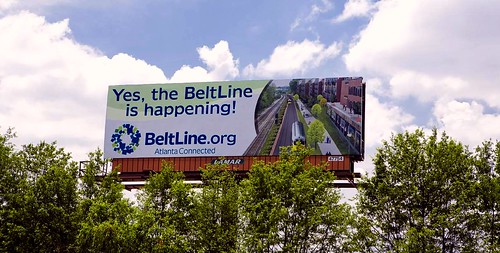
I am rooting hard for this massive, incredibly complex project. You should, too: if it succeeds, it will create an incredible model not just for Atlanta, but for cities around the world. But it has a long way to go. (The annual reports of the Atlanta BeltLine Partnership and ABI - cited extensively above - must be online, but I was unable to find either. My sense is that the two entities would benefit greatly from some communications help.)
Move your cursor over the images for credit information.
